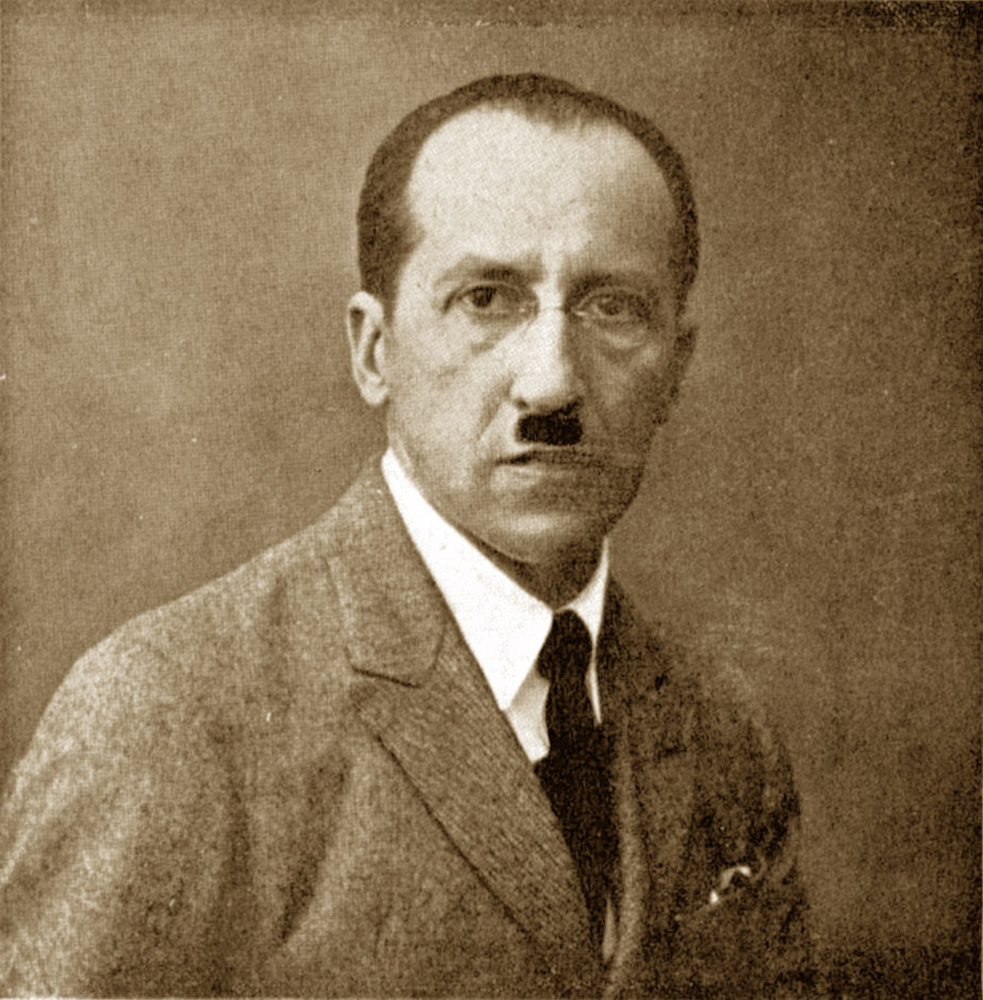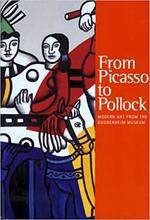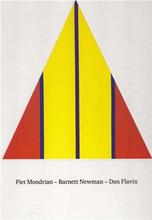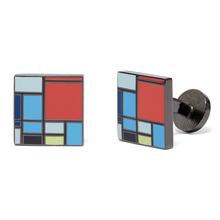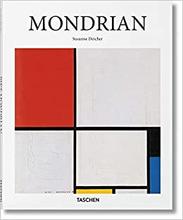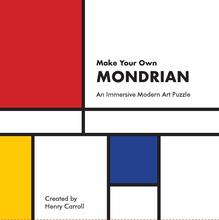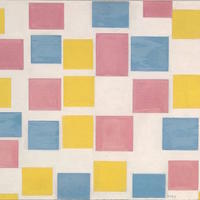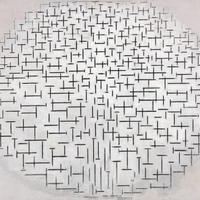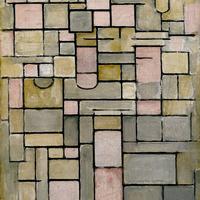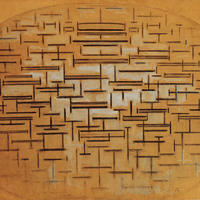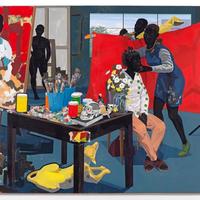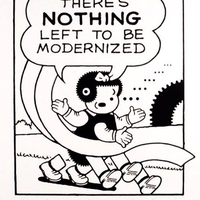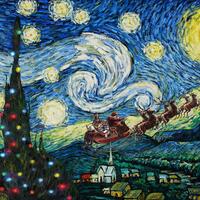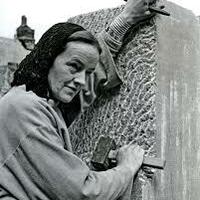More about Piet Mondrian
- All
- Info
- Shop

Contributor
Piet Mondrian painted the stems of fresh flowers white, even in his interior, green was a no-go!
At the age of 8, Mondrian moved from Amersfoort to Winterswijk. Those cities are only about 75 miles apart, but anyone who moved as a kid knows this can be a big deal. Also, in the Netherlands, a 30 minute commute will basically take you to the other end of the country. Anyway, "experts" are not sure if Mondrian really made friends as a kid, but since he either lived in or next to a school we can assume there were plenty of kids around. Mondrian was a loner though, his dad and uncle taught him drawing and painting from the age of ten, so he spent a lot of his time practicing.
Most people think Mondrian was this stiff, slightly autistic dude (might have something to do with his paintings...?) but that was only one side of his personality. He loved to go out and dance. Jazz was his favorite, but whenever artists became too popular he would move on. Music couldn't be a-rythmic enough for him, which makes me assume Mondrian would've absolutely loved dubstep. He was a really crappy dancer, his dancing skills were as linear and stiff as his paintings. He was such a bad dancer, his dance partners would write about it in letters to friends! #awkward
Mondrian enjoyed the company of women. During his time in Amsterdam, Mondrian taught painting classes to rich women and even dated some of them. He didn't just dance and date, Mondrian was engaged twice. First he proposed to Greta Heijbroek, which was "the biggest mistake of his life." His words not mine! Not because she was a terrible person though and she wasn't super ugly or anything. On the contrary, Mondrian says he got lost in her beauty and totally forgot about the most important thing in life: art. He eventually came to his senses and broke off the engagement. Phew! At the age of 59, while he was living the life in Paris, he fell head over heals in love with 19 year old Lily Bles. He re-did his entire house and studio especially for her- painting all his black walls white, bought a double bed, and made a crib from scratch. His upcoming father-in-law Mr. Bles wasn't too happy with their relationship and forced the couple to break off the engagement.
As a senior, Mondrian was still a ladies man. Story goes he and his much younger friend Peggy Guggenheim took a cab together, and he all of a sudden decided to kiss her. Okaaaaay... we wonder what her reaction was! During his time in NYC, Mondrian made more famous friends: Marc Chagall, Marcel Duchamp, Harry Holtzman, and Helena Rubenstein. Mondrian was a chain-smoker and eventually died of pneumonia, which didn't have a cure back in the early 1900s'. His famous friends all visited him on his short deathbed. At the time of his death, Mondrian was a central figure in the NYC art-world and pioneer of abstract art.
Fun fact: Piet loved Disney's "Snow white and the Seven Dwarfs." He didn't just like the story, when the animated movie came out in 1937 he was fascinated by the techniques used to create the movie. He wrote wrote letters about the movie to his brother Willem Frederik.
Thanks to my fellow alumni who ended up working at the Mondrian Museum and is a total expert on the man.

Sr. Editor
Maybe you’ve never heard of Piet Mondrian, but you’ve surely seen his signature geometric design.
The blue, red and yellow squares on a white background, separated by thick black lines is an instantly recognizable image. This abstract pattern of primary colors was all the rage in the Netherlands at the beginning of the 20th century. So much so that even though now we call it “neoplasticism” (whatever that means), the Dutch term is simply “De Stijl” or “The Style.” Mondrian basically invented it so yeah, he’s kind of a big deal.
Mondrian started out as a humble school teacher painting boring landscapes, proving yet again that revolutionaries are created not born! It was these grid paintings though that blew the lid off his art career, probably because duct tape hadn’t even been invented yet and everyone was in awe of his perfectly straight lines. Apparently he would spend so many hours painting them that his hands would blister, bringing him to tears. Who doesn’t love a tortured artist?
We certainly ate it up. His signature pattern is a staple of popular and consumer culture, fashion and commerce. Star appearances include:
- A 1933 line of luggage, scarves and other accessories by Hermès.
- Yves St. Laurent designed a “Mondrian Dress,” seen here on the cover of Vogue.
- Everyone's favorite musical TV group from the '70s, The Partridge Family, had a tour bus inspired by him.
- Nike designed a pair of Mondrian dunks.
- SFMOMA serves a Mondrian cake at their café. (Mmmmm, Mondrian à la mode!)
- And last, but certainly not least, this hilariously ‘80s music video for Force MD’s self-proclaimed “hit” Love is a House.
Featured Content
Here is what Wikipedia says about Piet Mondrian
Pieter Cornelis Mondriaan (
Dutch: [ˈpi:tər kɔrˈneːlɪs ˈmɔndrijaːn]), after 1906 known as Piet Mondrian (/piːt ˈmɒndriɑːn/, also US: /- ˈmɔːn-/,
Dutch: [pit ˈmɔndrijɑn]; 7 March 1872 – 1 February 1944), was a Dutch painter and art theoretician who is regarded as one of the greatest artists of the 20th century. He is known for being one of the pioneers of 20th-century abstract art, as he changed his artistic direction from figurative painting to an increasingly abstract style, until he reached a point where his artistic vocabulary was reduced to simple geometric elements.
Mondrian's art was highly utopian and was concerned with a search for universal values and aesthetics. He proclaimed in 1914: "Art is higher than reality and has no direct relation to reality. To approach the spiritual in art, one will make as little use as possible of reality, because reality is opposed to the spiritual. We find ourselves in the presence of an abstract art. Art should be above reality, otherwise it would have no value for man."
He was a contributor to the De Stijl art movement and group, which he co-founded with Theo van Doesburg. He evolved a non-representational form which he termed Neoplasticism. This was the new 'pure plastic art' which he believed was necessary in order to create 'universal beauty'. To express this, Mondrian eventually decided to limit his formal vocabulary to the three primary colors (red, blue and yellow), the three primary values (black, white and gray) and the two primary directions (horizontal and vertical). Mondrian's arrival in Paris from the Netherlands in 1911 marked the beginning of a period of profound change. He encountered experiments in Cubism and with the intent of integrating himself within the Parisian avant-garde removed an 'a' from the Dutch spelling of his name (Mondriaan).
Mondrian's work had an enormous influence on 20th century art, influencing not only the course of abstract painting and numerous major styles and art movements (e.g. Color Field painting, Abstract Expressionism and Minimalism), but also fields outside the domain of painting, such as design, architecture and fashion. Design historian Stephen Bayley said: "Mondrian has come to mean Modernism. His name and his work sum up the High Modernist ideal. I don't like the word 'iconic', so let's say that he's become totemic – a totem for everything Modernism set out to be."
Check out the full Wikipedia article about Piet Mondrian

